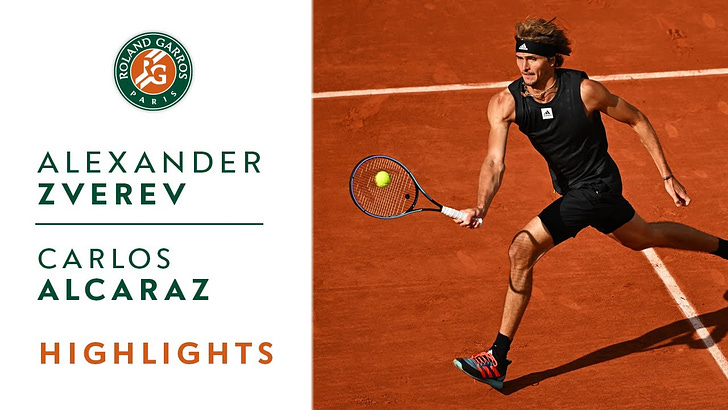Alexander Zverev defeated Carlos Alcaraz in four sets 6/4 6/4 4/6 7/6 in the first men’s quarterfinal at Roland Garros. It was Zverev’s first top-10 win in Majors and one of his finest performances that I can remember. For Alcaraz, it was his second quarterfinal loss in slams (US Open 2021 to Felix Auger Aliassime) but still a big step forward in the young Spaniard’s career.
Alcaraz
As I have discussed in previous match analyses involving Alcaraz, the playbook is out on him and the top players know exactly what you must do: get him moving to the forehand side. This isn’t to say he is easy to beat; he moves incredibly well and can still be dangerous from that side, but it is clear now that it is by far his weakest point on the court.
Maybe the narrative that gets marched out in the post-mortem of Alcaraz for this match will be “his inexperience showed” or “he was tired from night matches”, but if we look a the way he has been losing points the last 3 months of this clay swing, this was a very normal performance. Yes, he didn’t play well from the set position early on, but to Zverev’s credit, the big German kept him pinned most of the time, offering little chance to get multiple bites at a patient forehand.
Once again I tracked the winners and errors of both players when they were hitting topspin groundstrokes from the baseline.1 I find this metric cuts through the noise of easy winners and gives a hint as to how well a player can absorb pressure. Here are Alcaraz’s stats:
Key takeaways:
In line with prior matches, the Alcaraz running topspin forehand was a clear liability throughout most of this match. As I have discussed in prior match analyses:
“As much as I love the Alcaraz forehand, his initial set-up with an inverted racquet head and high elbow requires time to unload. It means the swing is a little ‘noisy’. It’s reminiscent of Thiem’s forehand when he first came on tour, and I think long-term drifting toward a lower elbow/modern forehand like Thiem did (and which subsequently allowed him to start winning on all surfaces against the Big-3) might make it even better.”
Alcaraz’s forehand is huge when on, but Zverev never gave him much time or rhythm today, and he did well to go hard and deep when hitting to that side for most of the match.
Uncharacteristically, Alcaraz’s backhand was missing a lot today. While I am a fan of the Alcaraz backhand when the ball is not too low or fast, his lack of racquet drop and outside set-up means he isn’t getting the outside of the ball very well, and against a truly world-class backhand like Zverev’s, the difference showed. For a deeper dive into the Alcaraz backhand and his limitations see here (circa ~5:25).
The Alcaraz drop shot/net game/ and overall finesse were once again excellent. In my opinion, the deficiencies in the bread-and-butter forehand and backhand aspects of his game have been papered over by the brilliance he displays consistently in this area of the game, and along with his athleticism and youthful fearlessness, it has won him multiple matches this year when the groundstrokes simply weren’t there.
Zverev
Zverev has been a consistent underperformer in slams throughout his career thus far; despite multiple deep runs he had never beaten a top-10 player. Today was his finest hour. Although I have gripes with Zverev’s forehand and serve technique, both held up very well today, and he executed a clear and simple game plan throughout. Here are Zverev’s numbers:
Key takeaways:
Zverev served very well today, serving at 71% and keeping his double faults to only 6. This allowed him to get plenty of short replies, and it really killed any chance for Alcaraz to build momentum. It showed in the dominance of Zverev in the 0-4 rally length points:

Zverev’s backhand was an exhibition. At 6’6’’ and with a wonderful high takeback that drops below the ball from the inside, he looked comfortable trading blows all day. Alcaraz always looked more susceptible to errors off that wing, and Zverev’s depth and pace made it hard for Alcaraz to shift into more forehand exchanges. This is partly the reason Alcaraz bled so many errors off both sides today; Zverev was crushing the backhand exchange harder than anyone can, and moving well enough to cover any line ball and—crucially—putting his running forehand back in play pretty well (something he doesn’t usually do well). He kept his running topspin forehand errors at 10 by my count, with only 4 across the first three sets.
Zverev’s movement was amazing. He got to a lot of drop shots and made some big plays in the cat-and-mouse exchanges.
Final Thoughts
Overall, this was by no means a bad loss for Alcaraz despite the heavy favorite tag. Zverev served exceptionally well and handcuffed Alcaraz into hard and deep backhand exchanges. He hit his forehand very well to keep errors on that side to a minimum, and moved across the whole court better than anyone for his height. If he keeps playing like he did today there is no reason he can’t win this tournament, but we’ve all known that for a long time now. The question is, can he? Djokovic or Nadal awaits in the semi-finals.
2nd serve returns were included where the player had a decent get on the ball. Slices, lobs, drop shots, and easy putaway balls/very short winners were committed.




